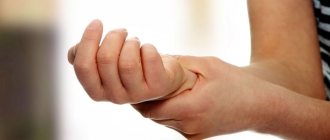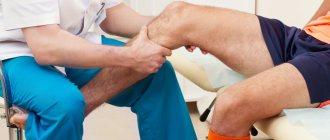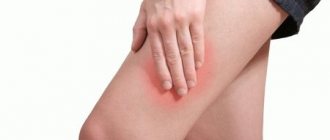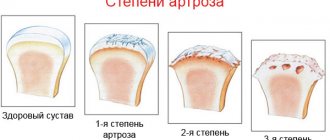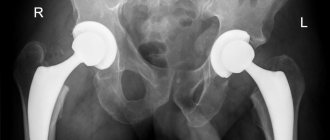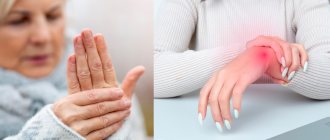Ankle pain
The ankle is a joint that connects the three largest bones of the limb (talus, fibula and tibia). The muscles that move these bones allow a person to move and stand.
Ankle pain in beginning runners may occur due to a sudden start to training for the body. Even with the correct technique and performing all the warm-up activities before the race, the chance that you will be able to avoid problems is far from 100 percent. This happens because the joints are simply not ready for such a heavy load.
As you get used to it, your ankle will stop hurting. Most often this happens after a certain period of time (for specifics, let’s estimate this period as 5 races). However, you do not need to overexert yourself at all during this time, and in general it is recommended to fix problem joints with an elastic bandage.
Causes of leg pain
Leg pain can occur when you land on your heel incorrectly.
Possible causes of pain below the knee after running:
- Not a good place for jogging. It is not recommended to run on uneven surfaces or asphalt. This is especially true for beginners. In this case, muscles and ligaments work in a state of sudden jumps and can become inflamed. As a result, a person suffers from microtraumas, pain in the feet, joints and soft tissues.
- There is no warm-up before classes, or it is done poorly. Before jogging, you need to thoroughly stretch all the muscles of your body. If you suddenly switch from a state of rest to active movements, the body will be subjected to severe stress.
- High speed. If you run too hard, you may experience severe pain in your legs due to active muscle contraction and overwork of ligaments and joints.
- Take a cold shower immediately after vigorous physical activity. The leg muscles swell and severe pain appears. This may interfere with future exercise and make it impossible to walk normally.
- Tight, uncomfortable shoes. Leads to leg pain during and after running.
- Excessive training. If weakness in the muscles, pain in the legs and a general loss of strength often occur, it means that the body is simply tired. When you exercise intensely, your body loses more protein than it takes in. As a result, immunity decreases, hormonal imbalance occurs, and women experience problems with the menstrual cycle.
Running technique
Incorrect technique is the main cause of ankle injuries in people who have just begun to devote some of their time to sports training.
People are used to running on their heels because it seems to us that we run faster and more efficiently. Sports shoe manufacturers are also helping with this by making sneaker soles thicker and adding more cushioning under the heel. With such running, especially on a regular basis, a load of double body weight falls on the knee and ankle joints , causing pain to new athletes.
Correct running is running in which the foot does not “stick” into the ground, the landing should occur on its first half (toes and ball), and the leg is not thrown forward, but placed under the center of gravity of the body. To master this technique, you can try barefoot running. In this case, due to the physical structure of the human body, the landing will occur correctly. Having remembered this position of the foot, you can begin to train in sneakers.
Warming up before running will help reduce the risk of injury You need to warm up for at least 10 minutes to get your blood flowing and prepare your muscles for physical activity. For warming up, well-known simple exercises are suitable for everyone: raising your toes to warm up the ankle joint , squats, rotating the knee joint .
Common runner injuries
Fatigue (stress) fracture
The source of bone pain is a stress fracture of the bone due to repeated impact loading. Bone responds to stress by becoming stronger, but if this stress is taken to excessive levels, microcracks and micro-tears appear in the bone. These repeated microfractures lead to a stress fracture.
The athlete feels pain while running, and sometimes when walking. With continued stress on the bone, a stress fracture results in a complete fracture of the bone. Stress fractures in runners typically occur in the lower part of the fibula and in the upper and lower parts of the tibia.
They can also, although less commonly, occur on the front of the lower leg. Read more about the injury, treatment and prevention in a separate material: Stress fracture: symptoms, prevention, treatment.
Shinsplit
Inflammation of the periosteum (shinsplit) is one of the most common injuries among runners. Shinsplit is characterized by severe or sharp pain, dull throbbing while running or even at rest. The area of pain is along the inner or outer edge of the lower leg.
Fortunately, shin injuries are often easy and quick to treat.
It is enough to stop running for a while, switching to non-impact cardio training, perform stretching exercises and strengthen the stabilizer muscles of the foot with non-impact exercise.
Although this is not a serious injury, it will not be possible to “overcome” it, because inflammation of the periosteum, if ignored, can lead to more serious pathologies of the tibia.
You can read in detail about the biomechanics of injury and its treatment in the article: Inflammation of the periosteum: how to treat and how not to get it.
Bursitis of the hip joint
Hip bursitis is accompanied by inflammatory changes in the joint cavities, which are responsible for the processes of lubrication and sliding when interacting with rubbing bone elements. The synovial periarticular bursa, where inflammatory processes occur, plays the role of a “shock absorber,” that is, it reduces friction between the bones and the soft tissues covering them.
With this injury, the pain is localized on the outside of the thigh. It can deceive a runner by the fact that at first its manifestations are strong, but as the pathological inflammation spreads, it becomes dull.
If bursitis is detected, the doctor will recommend limiting physical activity, which increases pain, and prescribe the patient non-steroidal anti-inflammatory drugs. A single injection of medication into the damaged bursa may also be necessary.
Read also: Why do joints hurt after running?
"Runner's Knee"
“Runner's knee” is the common name for a number of diseases affecting the knee joint. Most often, this term refers to patellofemoral pain syndrome, but also to patellar tendinitis and iliotibial tract friction syndrome.
With patellofemoral syndrome, pain affects the kneecap and the area under it. The pain is usually felt when climbing stairs, after sitting for a long time or after jogging.
Patellar tendonitis affects the ligament, which plays an important role in straightening the leg. In other words, this ligament becomes inflamed and runners feel pain at the bottom of the kneecap. At first, this pain is felt after the load, but as the injury progresses, the ligament sends painful signals even before the load.
With friction syndrome of the iliotibial tract, softening of the cartilage tissue occurs, which is fraught with gradual deformation of the entire joint. The area of pain is the outer surface of the knee joint. Usually this is severe pain, so that the athlete cannot continue exercising.
To treat and prevent knee pain, many use kinesiotaping, but it is important that the application be selected by a doctor. It’s a big mistake to take anti-inflammatory drugs and continue running without adjusting your schedule and load.
Podcast and article on the topic: Why do your knees hurt after running?
Ankle sprain
A sprain or tear in the ligaments surrounding the ankle occurs when the leg rotates inward. Has this ever happened to you when running over rough terrain? This may not always lead to a sprain, and if it does, the injury can be diagnosed by the presence of swelling and pain on palpation, most pronounced in the front of the ankle.
Treatment is successfully carried out independently: application of ice, compression, rest, elevated position of the limb.
To avoid injury, always warm up well, wear shoes that fit properly, and don't ignore exercises to strengthen the muscles surrounding the ankle joint.
Plantar fasciitis
In this injury, inflammation spreads to the tissues of the bottom of the foot, which extends from the heel to the toes. Inflammation can be caused by poor shoes and large amounts of uphill running. People with tight calf muscles and high arches are more prone to plantar fasciitis.
During treatment for plantar fasciitis, you should not heat your feet, but you should apply ice and massage. However, we strongly recommend that you immediately contact an orthopedic traumatologist if you suspect fasciitis. This injury does not go away for a long time, and if it is delayed, you can bring your leg to surgery.
Heel spur
This injury is sometimes confused with plantar fasciitis, being considered the same thing, however, a “spur”, or also osteophyte, is a bone growth that occurs due to plantar fasciitis. This growth of bone tissue in runners occurs due to longitudinal flat feet, excess weight or prolonged overload of the heels.
Osteophyte is characterized by severe and sharp pain when walking, it cannot be ignored, but self-medication will not help here! Athletes, trying to avoid pain, try not to step on the sore heel, which causes their gait to change and body weight to be distributed incorrectly. An overloaded outer edge of the foot leads to the formation of transverse flatfoot.
Treatment of calcaneal osteophyte can be either medicinal or using laser and x-ray therapy.
Causes of complications and prevention of ankle injuries
Problems with bones can cause difficulties when running, when the body does its best to signal deeper diseases, such as osteochondrosis. Joints and cartilage can deteriorate not only in older people. Therefore, in order not to worsen your situation, even if you have a seemingly banal curvature of the spine, you should consult a doctor before starting running.
Ill-fitting shoes can also lead to ankle injuries . High-quality running sneakers can, among other things, protect you from problems with your knees, lower back and back, since it is the shoes that absorb the load that your legs are forced to take when running. For long runs, you need to choose shoes that are slightly larger than the right size. For activities on asphalt and other hard surfaces - sneakers with additional cushioning. Modern manufacturers of sporting goods offer a wide selection of shoes with the ability to select them for an individual type of load. When it comes to clothes for running, you shouldn’t blindly follow the fashion for tight leggings - clothes that fit too tightly to the body impede the flow of blood to the limbs, the muscles experience oxygen starvation and begin to ache.
If pain in the ankle joint does not stop for more than a week, you should consult a traumatologist. To prevent and help with periodic joint pain, you can use warming massage and warm baths. Reducing the load or stopping it for 2-3 days will allow the ankle to rest.
You can also apply ointments to the joint. Well-known anti-inflammatory gels and ointments are suitable for everyone.
Injuries and illnesses
Even when following the rules exactly, runners experience pain after running below the knees. It is provoked by overloads and injuries, diseases of the limbs.
Due to injuries, damage to the meniscus, ligamentous apparatus, dislocations, inflammatory conditions, and pathological processes develop.
Problems with blood vessels
Systemic vascular diseases due to disturbances in the outflow of venous blood cause aching pain. It occurs unexpectedly and goes away on its own. If after running it hurts below the knee for this reason, diagnoses may be made: thrombophlebitis, varicose veins, endarteritis. Doctors categorically prohibit such patients from running until recovery.
Joint problems
Inflammatory processes in joint areas lead to arthritis, arthrosis, and bursitis. By not paying attention to why your legs hurt after running and continuing to exercise, a person is risking his health. The disease will not go away, it will progress, the pain will intensify. The joints will deteriorate over time. Jogging is excluded in this case.
Ligament tears
Inadequate loads and injury (especially when the track is uneven) lead to ligament rupture. Symptoms: sharp pain, swelling, swelling, limited joint mobility. If the ligament is completely torn, the skin turns blue and blood accumulates in the ankle. Apply a bandage immediately and seek medical attention.
Popliteal cyst injury
Due to pathological processes, a Baker's cyst may appear behind the knee. It is harmless and is a benign tumor. A complication of a cyst is its rupture as it increases in size. Having ruptured, the contents fall onto the shin, causing fever and aching pain.
Oncological diseases
At first they may be asymptomatic, later manifesting as painful conditions. A medical examination will help confirm or refute the predictions, so do not avoid a thorough examination by doctors.
How to recover your legs after running?
If you return from training and realize that your leg muscles are sore and “burning” after running, there are several ways to reduce the discomfort:
- Take a bath for 15-20 minutes. You can add sea salt, herbal infusions, a few drops of essential oils, and Epsom salt (magnesium salt) to the water. Warm water helps your leg muscles relax and speeds up their recovery process.
- Take a contrast shower. Start with warm water, gradually lowering its temperature. At the end, pour cold water over your feet and rub them with a towel until slightly red.
Relaxing your legs after running: massage
- Get a massage. If you have a special massage roller or ball, use them; if not, gently massage your calves, feet and toes with your hands. Good results are achieved by using special applicator mats. Massage helps muscles and myofascia relax, improves blood flow and minimizes the discomfort that occurs after a run. After the massage, apply Normaven® Foot Cream to the lower extremities. Thanks to the presence of plant extracts and oils, vitamins, menthol and panthenol, the product helps reduce the feeling of heaviness and fatigue, prevents the appearance of swelling and cramps, and also reduces the severity and improves the condition of the vascular pattern.
- Lie down with your legs on the back of the sofa or on the wall. The feet should be higher than the level of the heart: this improves blood circulation and helps get rid of pain in the legs after running (especially if the discomfort is caused by varicose veins and other vascular problems).
- If possible, try to sleep more. During sleep, the body recovers faster than during wakefulness. It is optimal to go to bed at 22.00, sleep duration is at least 7 hours.
- Eat right. Since pain in the legs after running is most often caused by microdamage to the muscles, it is important to give them material for a speedy recovery - we are talking about protein foods.
- Maintain drinking regime. During intense and prolonged training, dehydration occurs, so you need to replenish fluid loss. In addition, the body loses electrolytes along with liquid, so it is recommended to drink mineral water, such as magnesium water.
Expert opinion
If after a run you feel very tired and sore in your leg muscles, do not under any circumstances try to overcome it and go jogging again the next day. The thesis that there is no result without pain is fundamentally wrong: blindly following this postulate can lead to more serious consequences, even injury.
Vascular surgeon, phlebologist
Osipova Ekaterina Yakovlevna
It is important to maintain proper drinking regime when running
Prevention
To ensure that the aching pain that occurs at the beginning of classes stops, preventive measures are used. Perform the movements correctly: tighten your stomach, work rhythmically with your arms, lift your torso as you inhale, roll from toe to foot.
To remove decay products, it is recommended to drink a lot - water, and not tea or coffee, which dehydrate the body.
Exercise regularly, without long breaks. Warm up before your run. Finish the workout smoothly so as not to accumulate lactic acid; switch from running to walking.
Watch your diet (eat foods rich in magnesium, potassium and calcium).
